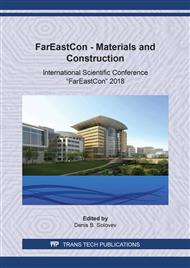[1]
D. Dudkin V. Kisilenko, A. Smirnov, Steel production. Continuous Casting, Teplotechnik. Moscow. (2009).
Google Scholar
[2]
S. Kittaka, Multi-Mode EMS for Slab Casters – Recent Improvements and New Applications. Nippon steel techical Report. 86 (2002) 68-73.
Google Scholar
[3]
Kubota, J., Steel flow control with travelling magnetic field for slab continuous caster mold. Tetsu-to-hagane. 4 (2000) 271-277.
DOI: 10.2355/tetsutohagane1955.86.4_271
Google Scholar
[4]
F. Chowaniec, The comparison of roundand square billets casting from peritectic steel grades. 2nd International Metallurgical Conference. Trinec. (1997) 139-143.
Google Scholar
[5]
A. Eldarkhanov, V. Efimov, A Nuradinov The processes of casting formation and their modeling. Mashinostoenie. Moscow. (2008).
Google Scholar
[6]
A. Smirnov, V. Pilushenko, S. Momot, Solidification of a metallic melt under external influences. VIK. Donetsk. (2002).
Google Scholar
[7]
O. Nosochenko, O. Isaev, L. Lepikhov, Decrease in centerline segregation in strand by means of microalloying. Metallurgist. 6 (2003) 45-46.
Google Scholar
[8]
A. Belii, Central segregation heterogeneity in continuously cast sheet blanks and plate. Metallurgizdat. Moscow. (2005).
Google Scholar
[9]
Duan Zhen-Hu, Shen Hou-Fa, Liu Bai-Cheng, A Numerical Study of the Effect of Multiple Pouring on Macrosegregation in a 438-Ton SteelIngot. Acta metallurgica sinica-english letters. 28 (2015) 1123-1133.
DOI: 10.1007/s40195-015-0303-z
Google Scholar
[10]
N. Zyuban, D. Rutskii, , S. Konovalov, S. Gamanyuk, A Study of the Development of Chemical Heterogeneity in Large Forging Ingots: Depending Upon the Configuration and Thermophysical Conditions of Casting. MMTA. 45 (2014) 6200-6206.
DOI: 10.1007/s11661-014-2577-6
Google Scholar
[11]
D. Rutskii, N. Zyuban, S. Gamanyuk, Effect of Liquid-Solid Pouring on the As-Cast Structure and the Distribution of Nonmetallic Inclusions in a 24.2-t Steel 38KhN3MFA Ingot, Russian metallurgy. 5 (2017) 376-383.
DOI: 10.1134/s0036029517050093
Google Scholar
[12]
Duan Zhen-Hu, Shen Hou-Fa, Liu Bai-Cheng, A Numerical Study of the Effect of Multiple Pouring on Macrosegregation in a 438-Ton SteelIngot. Acta metallurgica sinica-english letters. 28 (2015) 1123-1133.
DOI: 10.1007/s40195-015-0303-z
Google Scholar
[13]
W. Yang, J. Zhao, S. Song, S. Qiu, Numerical simulation of filling and solidification process of large steel ingot. Special Casting and Nonferrous Alloys. 34 (2014) 149-152.
Google Scholar
[14]
Z. H. Zhang et al., Numerical Simulation of Filling Process in Large Steel-Ingot. Applied Mechanics and Materials. 395 (2013) 1212-1217.
DOI: 10.4028/www.scientific.net/amm.395-396.1212
Google Scholar
[15]
Shen Houfa; Chen Kangxin; Liu Baicheng, Numerical Simulation of Macrosegregation in Steel Ingot Casting, Acta metallurgica sinica. 49A (2018) 1470-1474.
Google Scholar
[16]
S.Gamanyuk, N. Zyuban, D. Rutskii, Mathematical modeling of the steel ingot teeming and the solidification process. IOP Conference Series-Materials Science and Engineering. 177 (2017) 012064.
DOI: 10.1088/1757-899X/177/1/012064
Google Scholar
[17]
Bagmutov V.P., Zaharov I.N., Zhul`Ev S.I., Zyuban N.A., Rutskii D.V., Volgograd State Technical University: State registration certificate of the computer program Crystal, computer simulation system No. 2013613206. RF. (2013).
Google Scholar
[18]
A. Mozgovoi, S Zhul'Ev, N. Zyuban, D. Fedorov, D Rutskii, Study and optimization of the parameters of ingots for obtaining heavy rolled sections. Metallurgist. 52 (2008) 439-445.
DOI: 10.1007/s11015-008-9070-7
Google Scholar
[19]
D. Rutskii V, N. Zyuban, S. Gamanyuk, A study of the hot top performance with various heat insulators, Solid State Phenomena. 265 (2017) 1099-1103 https://doi.org/10.4028/www.scientific.net/SSP.265.1099.
DOI: 10.4028/www.scientific.net/ssp.265.1099
Google Scholar
[20]
А. Mozgovoy, N. Zyuban, D. Rutskii, Patent No 84759. RF. (2006).
Google Scholar


